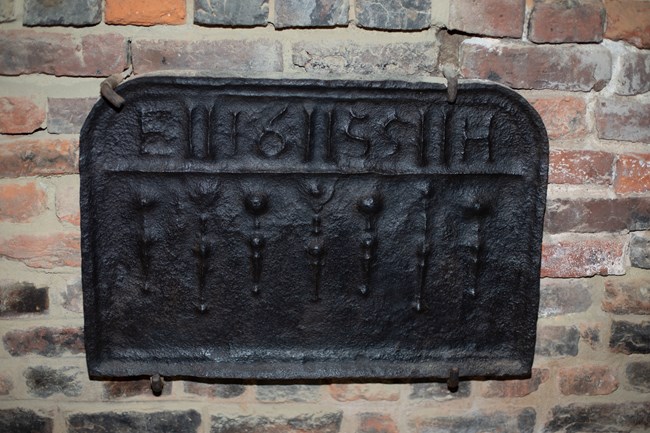Last updated: February 24, 2022
Article
Firebacks
Two of the most impressive pieces of iron work in our collection are two firebacks that were made at Saugus Iron Works in the 17th century. Firebacks, also called “iron backs” or “cast backs” in the 17th century, were designed to sit against the back of a fireplace and protect the bricks from the direct heat of the fire. They would also reflect some of the heat back into the room. Firebacks that were placed in the nicer rooms of the house, like the parlor, would be highly decorated to match the fashion of the expensive furniture in the room.

NPS Photo / Claire Norton
Fireback or Cast Back, 1655
Made at Saugus Iron Works
Iron
Gift, First Iron Works Association
SAIR 651

NPS Photo
Fireback or Cast Back, 1656
Made at Saugus Iron Works
Iron
Gift, Essex National Heritage Area
SAIR 12322
Firebacks were custom ordered, and usually included the initials of the owner, and the date they were made. Fireback SAIR 651 has the date “1655” on it, as well as the initials “EH.” The current theory is that the initials are those of Edward Hutchinson, a Boston Merchant who was appointed the agent, or manager, of the iron works between about 1654 and 1657. The other fireback, SAIR 12322, has no initials on it, but it does have the date 1656. It is possible this is one made as a generic item to be sold.

Denis Diderot’s Encyclopedia of Trades and Industry, 1751
A fireback started as a wooden mold, either carved with a design, or with ornaments and letters glued or nailed onto a board. This illustration of iron making shows the process, pretty much unchanged a century later when Denis Diderot wrote his encyclopedia of trades and industry in 1750. At the back of the foundry against the wall a completed fireback can be seen with a cherub face on it. In the foreground, the iron workers have dug a trench in the sand on the foundry floor starting at the letter “Y” at the left from the mouth of the blast furnace. In the center of the image, where it says “figure 4” one workman is pressing the wooden form of the fireback into the sand on the floor. When the blast furnace is tapped, molten iron will run out of the furnace down the trench and into the molded fireback.

NPS Photo
The design of our firebacks follow the style of the mid-17th century. On both firebacks, you can see the use of “split turnings”—decorations made of a turned piece of wood like a banister or a spindle on a chair that was split in half and applied to a flat surface to make a raised element. Another common decoration is “bosses”—raised dots that like the split turnings were applied in designs to the front of expensive furniture. On furniture, the decorations were usually stained or painted, as on our reproduction court cupboard standing near the parlor fireplace in the Iron Works House.
Although Saugus Iron Works must have produced a number of firebacks when it was operational between 1646 and 1670, there are only seven known firebacks in existence. Saugus Iron Works is fortunate to have the two oldest. The others are located at the Peabody Essex Museum in Salem, MA (dated 1660); the Pickering House in Salem, MA (dated 1660); Pilgrim Hall in Plymouth, MA (dated 1660); Historic New England in Boston, MA (dated 1660); and The House of the Seven Gables in Salem, MA (dated 1662).
Diderot, Denis. A Diderot Pictorial Encyclopedia of Trades and Industry: 485 Plates Selected from ‘L’Encyclopedie of Denis Diderot, (1751), Dover Publications, Inc., New York, 1987).
Fairbanks, Jonathan L. and Robert F. Trent. New England Begins: The Seventeenth Century, Volume 2: Mentality and Environment. (Boston: Museum of Fine Arts, Boston, 1982), p. 357-359.
Hartley, E. N. Ironworks on the Saugus. (Norman, OK: University of Oklahoma Press, 1957).
